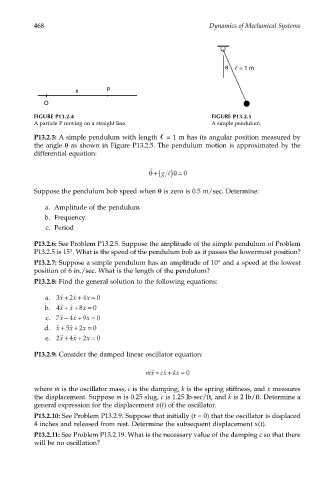Page 487 - Dynamics of Mechanical Systems
P. 487
0593_C13_fm Page 468 Monday, May 6, 2002 3:21 PM
468 Dynamics of Mechanical Systems
θ = 1 m
x P
O
FIGURE P13.2.4 FIGURE P13.2.5
A particle P moving on a straight line. A simple pendulum.
P13.2.5: A simple pendulum with length = 1 m has its angular position measured by
the angle θ as shown in Figure P13.2.5. The pendulum motion is approximated by the
differential equation:
˙˙ g l θ
θ +( ) = 0
Suppose the pendulum bob speed when θ is zero is 0.5 m/sec. Determine:
a. Amplitude of the pendulum
b. Frequency
c. Period
P13.2.6: See Problem P13.2.5. Suppose the amplitude of the simple pendulum of Problem
P13.2.5 is 15°. What is the speed of the pendulum bob as it passes the lowermost position?
P13.2.7: Suppose a simple pendulum has an amplitude of 10° and a speed at the lowest
position of 6 in./sec. What is the length of the pendulum?
P13.2.8: Find the general solution to the following equations:
a. 3˙˙ x + 2 ˙ x + 4x = 0
b. 4˙˙ xx++ 8x = 0
˙
c. 7 ˙˙ x − 4 ˙ x + 9x = 0
d. ˙˙ x + 5 ˙ x + 2 x = 0
e. 2˙˙ x + 4 ˙ x + 2x = 0
P13.2.9: Consider the damped linear oscillator equation:
+
+
˙˙
˙
mx cx kx = 0
where m is the oscillator mass, c is the damping, k is the spring stiffness, and x measures
the displacement. Suppose m is 0.25 slug, c is 1.25 lb⋅sec/ft, and k is 2 lb/ft. Determine a
general expression for the displacement x(t) of the oscillator.
P13.2.10: See Problem P13.2.9. Suppose that initially (t = 0) that the oscillator is displaced
4 inches and released from rest. Determine the subsequent displacement x(t).
P13.2.11: See Problem P13.2.19. What is the necessary value of the damping c so that there
will be no oscillation?

